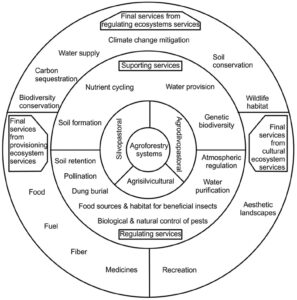What is agroforestry?
Agroforestry is the integration of woody perennials, such as trees and shrubs, with crops, livestock, or fish production to create environmental, economic, and social benefits (Fig. 1).
Many different types of agroforestry systems exist and can be classified as agrisilvicultural, silvopastoral, or agrosilvopastoral systems.

1. Agrisilvicultural systems: Trees combined with crops
Examples: Improved fallows, temporal intercropping of trees and crops (“taungya”), alley cropping, spatial intercropping of trees and crops (homegardens, multistory tree and crop combinations, nitrogen-fixing trees, shade trees, trees for soil conservation, energy crops), and spatially adjacent trees and crops (woodlots on farms, windbreaks, live fences, riverine buffer plantings).
2. Silvopastoral systems: Trees combined with pastures or animals
Examples: Trees on rangeland or pastures, protein-rich tree fodder on farm or rangelands, tree crops with animals grazing underneath. See also trees combined with crops above.
3. Agrosilvopastoral systems: Animals, trees and crops
Examples: Homegardens involving animals, apiculture (i.e., beekeeping) with crops and trees. Other examples include the items listed under agrisilvicultural systems and silvopastoral systems.
Agroforestry systems can involve land-use change, for example, clearing of forest for coffee or cocoa plantations. Other relevant components of agroforestry are similar to those for crops and livestock.
Depending on the type of agroforestry, these systems can also sometimes provide climate change adaptation benefits by buffering heat, variability in moisture, and extreme events.
Emissions by source
Greenhouse gas (GHG) emissions associated with agroforestry are related to the crop or livestock management practices used (such as use or management of tillage, manure, fertilizer, etc.). One challenge of agroforestry is understanding interactions among individual practices. For example, tree roots may absorb nitrogen fertilizer that would have otherwise gone to the crop or been leached and emitted as indirect nitrous oxide.
Agroforestry systems are also a promising management strategy to increase aboveground biomass and soil carbon (C) stocks (C mitigation or sequestration). Agroforestry systems can sequester atmospheric C as the tree crops take in CO2 via photosynthesis, storing C in tree biomass and, eventually, in the soil through root turnover and leaf litter. The amount of C sequestered is dependent on the agroforestry system, climate, soils, previous land use, and time since a land-use change.
For example, Feliciano et al. (2018) demonstrated that (i) silvopastoral systems sequester more soil C (4.4 tC ha−1 yr−1) relative to other agroforestry systems, (ii) that soil C sequestration rates are greater in tropical climates (2.2 tC ha−1 yr−1) when compared to agroforestry systems in other climates, and (iii) the greatest above-ground C sequestration occurs when degraded land is transitioned to improved fallow (12.8 tC ha−1 yr−1).
Mitigation strategies
Agroforestry leads to GHG mitigation if it increases biomass C compared to prior land use. In livestock systems, introducing trees can offset enteric fermentation emissions and reduce overall emission intensity, or emissions on a per-product basis (e.g., Mg CO2e per kg of meat). Agroforestry can also increase soil organic C, provide fossil fuel energy substitutes, or provide substitutes for synthetic nitrogen fertilizer through the use of nitrogen-fixing species.
Thevathasan et al. (2004) showed that agroforestry reduced nitrous oxide emissions by 0.7 kg ha-1 yr-1 by requiring fewer fertilizer inputs relative to conventional cropping systems. Using wood fuel from agroforestry systems allows people to meet their energy needs in a less C-intensive way compared to fossil fuels.
In addition, sourcing harvested wood products from trees on-farm decreases the need to cut native forest trees, likely reducing levels of forest clearing and associated deforestation rates.
The impacts of agroforestry need to consider the net impacts of the combination of the associated crop, tree and land-use change, not only the additional biomass C and nitrogen fixation from the trees. Impacts may vary as well depending on the time period of the system and whether tree products are harvested.
